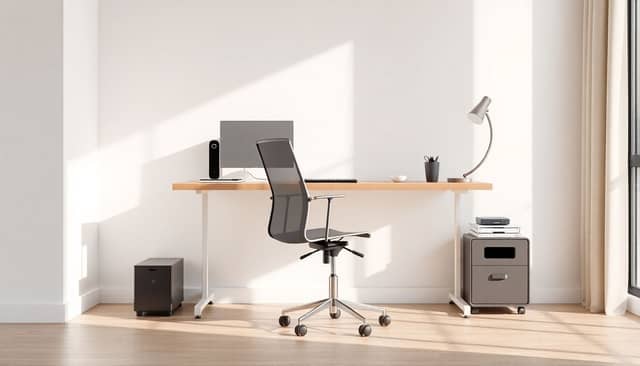Table of Contents
I get it—long hours at the desk can leave authors feeling stiff and frustrated. Sitting in the wrong position can lead to discomfort and even slow down your writing flow. But don’t worry, there are simple ways to make your workspace more comfortable and help you write better. Keep reading, and you’ll find tips on choosing the right desk, setting it up properly, and keeping your long writing sessions pain-free.
If you stick around, I’ll show you how to pick an adjustable ergonomic desk that fits your needs, highlight what features matter most, and share easy setup tricks. Plus, I’ll give you advice on pairing it with the perfect chair and some quick tips to stay comfortable even during those marathon writing hours. It’s easier than you think to upgrade your workspace and feel good while you write.
Let’s explore how to create a cozy, supportive space that keeps you comfy and focused, no matter how long your story takes to unfold.
Key Takeaways
Key Takeaways
- Using a height-adjustable desk helps prevent discomfort by letting you switch between sitting and standing, reducing muscle strain during long writing sessions.
- Look for a sturdy, versatile desk with smooth electric or manual adjustment, a wide surface (at least 48″ x 24″), and features like memory presets to support your writing needs.
- Proper setup, like keeping your monitor at eye level and your keyboard close, improves posture and cuts down on neck, shoulder, and wrist pain.
- Pair the desk with a good ergonomic chair that offers adjustable height, lumbar support, and comfort, and remember to take regular breaks and stretch.
- Simple habits like stretching, staying hydrated, and alternating between sitting and standing help maintain comfort during lengthy writing periods.
- Market data shows rising demand for ergonomic desks, especially electric sit-stand models, with options available across different budgets to support healthier long-term writing habits.

Choose the Best Adjustable Ergonomic Desk for Your Writing Comfort
If you're serious about writing comfortably at home or in your office, an ergonomic desk that can adjust to your needs is a game-changer. The most popular choice among authors is a height-adjustable desk that allows you to switch between sitting and standing throughout your writing sessions. These desks help reduce the risk of musculoskeletal issues caused by prolonged sitting, which research shows can average over 11 hours of sedentary time daily for office workers.
Look for desks with a smooth, effortless height adjustment mechanism—whether electric or manual—that can support your preferred working position. An adjustable desk should offer a good range of heights, ideally from about 24 inches to 50 inches, to accommodate various user sizes and preferences.
Popular options in the market, like sit-stand desks, are increasingly favored for their flexibility. Given that the global ergonomic height-adjustable desk market is set to reach over $500 million by 2025, investing in a quality model is worth considering. For authors, a spacious surface that can hold your laptop, notes, and reference materials is equally vital. Some desks come with cable management features, helping keep your workspace tidy and distraction-free.
Prioritize Key Features When Selecting an Ergonomic Desk for Authors
Choosing the right desk isn't just about looks—it's about features that support long writing hours. Start with a sturdy frame that can handle your equipment with stability. An electric, easily programmable height adjustment feature makes switching from sitting to standing smooth, minimizing interruption and fatigue.
Surface area matters too—aim for a desk that provides at least 48 inches wide and 24 inches deep to comfortably accommodate your setup. Adjustable desks with memory presets are handy, allowing you to save your preferred heights for sitting and standing. Some desks incorporate anti-collision technology, preventing accidental bumps or drops during adjustments.
Given the rising demand for ergonomic home office furniture, this segment is expanding rapidly. The global standing desk market is estimated at nearly $8 billion in 2025, with choices ranging from budget-friendly manual models to high-end electric units. Remember, selecting a desk with features that match your workflow and physical needs will make a noticeable difference in your writing comfort.

Set Up Your Desk Properly for Better Posture and Reduced Strain
Getting your desk arrangement right can make a huge difference in how comfortable you feel during long writing sessions.
Start by adjusting your desk so that your monitor is at eye level—this prevents neck strain and encourages good posture.
Place your keyboard and mouse close enough so your elbows stay bent at roughly 90 degrees, reducing shoulder tension.
Use a footrest if your feet don’t comfortably reach the ground, promoting better circulation and alignment.
Don’t forget to position your chair height so your lower back is supported, and your knees are about level with your hips.
Keep frequently used items within arm’s reach to avoid unnecessary stretching or twisting.
Consider ergonomic accessories like monitor arms, wrist supports, or standing desk converters to fine-tune your setup.
Pair Your Desk with the Right Chair to Support Long Writing Sessions
A good chair is just as important as a good desk when it comes to comfort and health during writing.
Look for a chair that offers adjustable height, lumbar support, and breathable material—the goal is to keep you comfortable without pressure points.
Make sure your feet are flat on the ground or on a footrest, and your thighs are parallel to the floor.
Adjust the armrests so your shoulders stay relaxed and your arms can rest naturally while typing.
If your chair doesn’t support lumbar curvature, consider adding a cushion or lumbar pillow for extra help.
Take breaks regularly and switch positions to avoid stiffness—your chair should encourage movement, not confinement.
Investing in a quality ergonomic chair can make a noticeable difference in your energy levels and overall comfort over time.
Incorporate Easy Tips to Maintain Comfort During Extended Writing Time
Even with the best setup, long hours can still take a toll on your body. Simple habits can help keep you comfortable and healthy.
Set a timer to remind yourself to stand or stretch every 30 to 60 minutes—breaks keep blood flowing and muscles relaxed.
Practice some quick stretches—neck rolls, shoulder shrugs, and wrist flexes—to alleviate tension.
Stay hydrated and avoid caffeine — dehydration can cause fatigue and muscle cramps.
Alternate between sitting and standing if you have a height-adjustable desk—this prevents fatigue and promotes circulation.
Adjust your workspace lighting to reduce eye strain and improve focus, especially if you work into the evening.
Pay attention to your posture; keep your back straight and shoulders relaxed, and avoid hunching over your keyboard.
Lastly, listen to your body. If you start feeling discomfort or pain, it’s better to take a break or readjust your setup.
Market Trends and Data: Why Choosing the Right Ergonomic Desk Matters Now More Than Ever
The global market for ergonomic height-adjustable desks is booming, expected to hit around $529 million in 2025, thanks to more people working from home and concerns over sitting too much.
With a compound annual growth rate of 15.3% between 2025 and 2033, this segment continues to expand, reflecting how much people are prioritizing health and comfort in their workspaces.
In North America alone, the standing desk market is valued at nearly $8 billion, with the US market contributing over $2.3 billion by 2025, showing the demand for quality ergonomic solutions.
Given that office workers sit around 11.6 hours daily on average, investing in a good sit-stand desk can reduce these sedentary hours significantly.
Sales of electric standing desks are on the rise—on Amazon early 2025, search volumes peaked at 466.3, with positive reviews highlighting ease of assembly and functionality.
As the market continues to grow, so does the variety of options—manual, electric, high-end, budget-friendly—allowing you to find a model that fits both your needs and budget.
Choosing the right desk isn’t just about comfort; it’s a health decision backed by data showing increased satisfaction and decreased musculoskeletal risks when proper setups are used.
Stay informed about new innovations and market trends to make smart investments that support your long-term writing health.
FAQs
Choose a desk with easy height adjustment, smooth movement, and a stable surface. Consider size, weight capacity, and whether it offers programmable presets for quick changes during long writing sessions.
Adjust the desk height so your elbows are at a 90-degree angle, your monitor is at eye level, and your feet are flat on the floor. Maintain a neutral wrist position and keep your back supported naturally.
Take regular breaks, stretch periodically, and adjust your desk height as needed. Using ergonomic accessories like wrist supports can also reduce strain during extended periods of writing.



